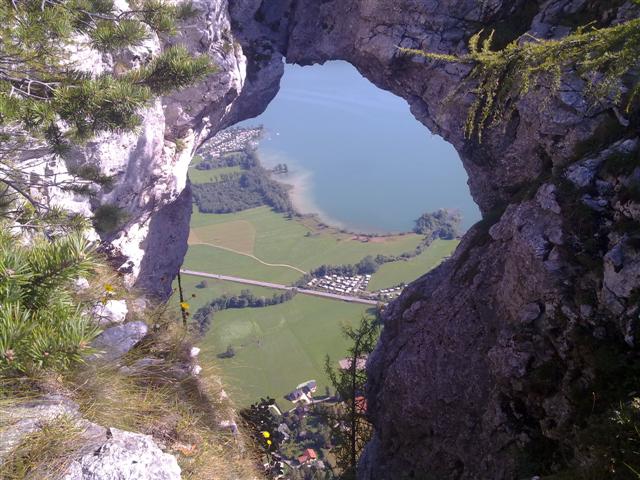
DRACHENLOCH - Hole of the Dragon
MountainNinja´s Cache Nr. 94 (Earth Cache Nr. 8)


Gelogische Erklärung: Das Drachenloch in der Drachenwand war ursprünglich eine Karsthöhle und ist im Laufe der Zeit durch die ganze Wand gebrochen. Durch zusätzlich Erosion konnte dieses Naturphänomen entstehen. Vorraussetzung für das Entstehen von Kalksteinhöhlen sind Wasser und das Kalkgestein. Die Höhlen entstehen, indem Oberflächenwasser durch feine Spalten und Risse in das Kalkgestein eindringt. Beim Durchlaufen der Humusschichten nimmt das einsickernde Wasser Kohlendioxid auf und es bildet sich hierbei eine schwache Kohlensäure. Dieses mit Kohlendioxid angereicherte Wasser ist in der Lage das Kalkgestein aufzulösen. Das eindringende Wasser schafft sich somit langsam aber sicher immer größer werdende Risse und Klüfte. Durch das Zusammenfließen von mittlerweile mit Kalk gesättigtem Wasser, sind diese Lösungen in der Lage, erneut Kalk zu lösen. Man nennt diesen Prozess auch Mischungskorrosion. Diese Lösungsprozesse brauchen jedoch eine extrem lange Zeit, woraus sich auch das hohe Alter unserer Kalkhöhlen erklärt. Es werden hierbei nur wenige Zentimeter Kalkgestein innerhalb von tausend Jahren gelöst.
Siehe auch Earthcache Teufelsloch - Devils Hole !!!
Das Drachenloch in der Drachenwand bei St. Lorenz am Mondsee ist ein sogenanntes "Sonnenloch"! Sonnenlöcher sind Felslöcher, durch die an bestimmten Tagen im Jahr die Sonne durchscheint. Jener Durchgangsstrahl fällt dann im Tal auf Orte, die zu Kraftorten und Kultplätzen wurden. Meist sind Kirchen und Marterl auf jenen „Sonnenorten“ zu finden.
Wenn nun die Sonne im Winter, zur Mittagszeit, hinter der Drachenwand vorbeizieht, dann tritt der Fall ein, dass die Sonne für kurze Zeit ihre Strahlen durch das Loch im Berge wirft und in die schattige Landschaft eine Lichtspur zeichnet, die etwa eine Kreisform hat. Menschen der Frühzeit haben vielleicht diese Naturerscheinung beobachtet und diese Lichtspur durch Steinsetzungen in der Ebene markiert. Auf diese Weise haben sie eine Sonnenuhr und einen Sonnenkalender erhalten. Ähnliche Anlagen sind uns in anderen Ländern erhalten geblieben. In unserer Zeit hat man im Zuge der Christianisierung die Zeugnisse einer “großartigen heidnischen Vorzeit” weggeräumt, bis auf wenige Punkte, auf denen Bildstöcke, Kapellen, Kirchen und andere Heiligtümer hingestellt worden sind. Es ist anzunehmen, dass sich die Kirche von St. Lorenz auf einem solchen Punkt befindet.
Bei Beobachtungen sind weitere Postitionen zum Beobachten des Sonnendurchganges bekannt geworden: Ein kleiner unscheinbarer Holzbildstock, der ziemlich genau nördlich vom Drachenloch steht und eine kleine Kapelle zw. St. Lorenz und Plomberg. Beide Objekte begrenzen etwa den Sektor, in dem das Drachenloch sichtbar ist. Man kann nun in diesem Sektor beliebig umherwandern und zur gegebenen Zeit das Sonnenphänomen durch das Drachenloch beobachten. Auch ist das Begleiten des Lichtstrahles möglich.
Orte und Zeitpunkte zur Beobachtung des Sonnendurchgangs beim Drachenloch:

Um diesen Earthcache loggen zu dürfen, MUSST Du zum Drachenloch hinaufsteigen (z.B. Klettersteig)
sowie ein Foto von Dir im Drachenloch posten - Siehe Beispielbild!
Die Terrainwertung 5 bezieht sich auf den Klettersteig - sonst ist sie 4.
Beantworte mir per mail wie hoch und breit das Loch ungefähr ist.
Du brauchst meine Logerlaubnis nicht abwarten!

The dragon's hole in the dragon's wall was originally a mattock cave in the limestone and has broken in the course of the time through the whole wall, in addition still there came erosion. A prercondition for the forming of limestone caves are water and the lime rock. The caves originate, while surface water penetrates by fine columns and tears into the lime rock. While going through the humus layers the trickling water takes up carbon dioxide and it forms, on this occasion, a weak carbonic acid. This water fortified with carbon dioxide is able to dissolve the lime rock. The penetrating water creates therefore slowly indeed greater and greater growing tears and gaps. By flowing together of water meanwhile saturated with lime, these solutions are able to solve once more lime. One calls this process also mixture corrosion Nevertheless, these solution processes needs an extremely long time what also the old age of our lime caves explains itself. On this occasion only few centimetres of lime rock are solved within thousand years.
The dragon's hole in the dragon's wall at Saint Lorenz Mondsee is a so-called "solar hole"! Solar holes are rock holes by which on certain days in the year the sun shines through. Then that passageway ray falls in the valley on places which became cult places. Mostly churches and "Marterl" are to be found on those "solar places".
If now the sun passes in winter, at the midday, behind the dragon's wall, the case enters, that the sun throws for a short time her rays through the hole in the mountain and in the shady scenery possibly draws a light track, which has the form of a circle. People of the early time have observed this natural phenomenon and marked this light track by Stone settlements. In this manner they have received a solar clock and a solar calendar. Similar arrangements have been preserved to us in other countries. In our time one has in the course of the christianisation the reports of a “great pagan prehistoric time” cleared, up to few points, on which blocks, chapels, churches and other sanctums have been put. The church of Saint Lorenz is built on one such point.
With observations other postitionen have become known for observing of the solar passageway: A small insignificant wooden block which stands quite exactly to the north of the dragon's hole and a small chapel between Saint Lorenz and Plomberg. Both objects limit possibly the sector in which the dragon's hole is visible. Now one can walk around within this sector and - at the given time - observe the solar phenomenon by the Dragon's hole. Accompanying the beam of light is also possible.
To get credit and claim a "Find" for this EarthCache you MUST climb up to the Dragon´s hole,
post a picture of yourself/s in front of the hole (Beispielbild)!
Tell us via email how high and wide you estimate the hole is.
Do not wait for my logpermission!



|